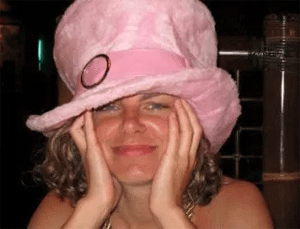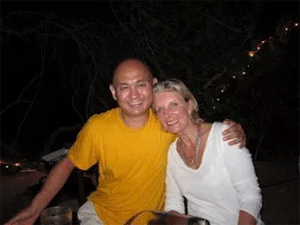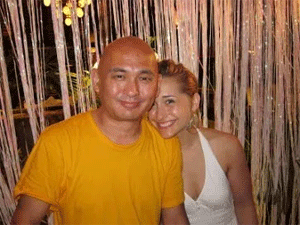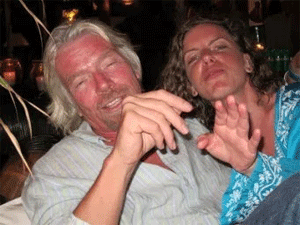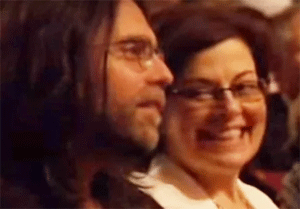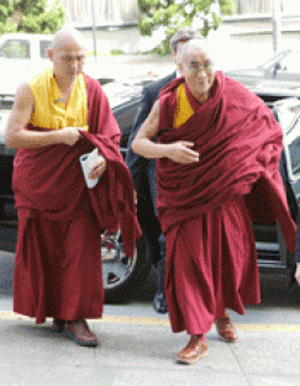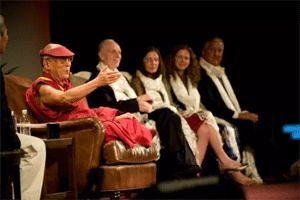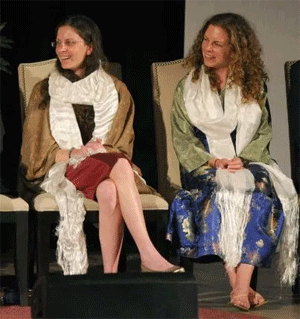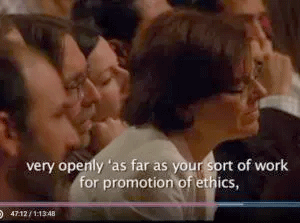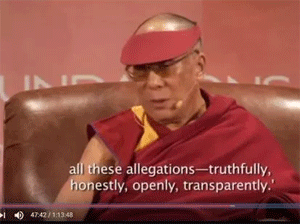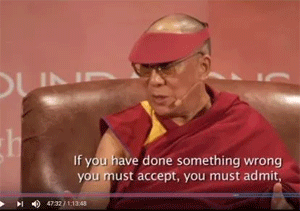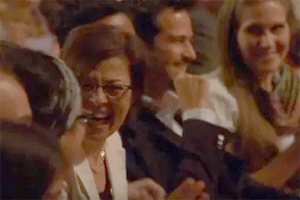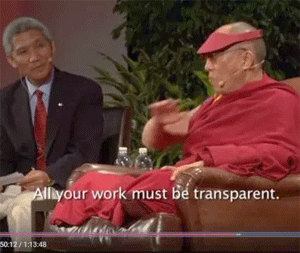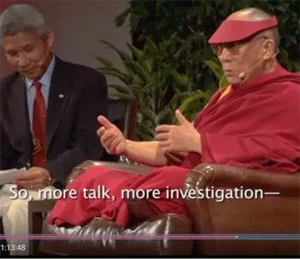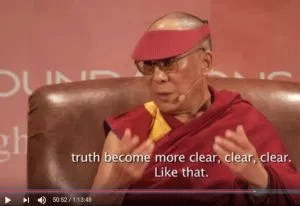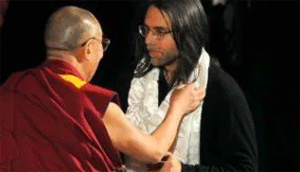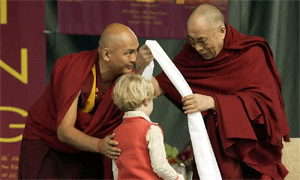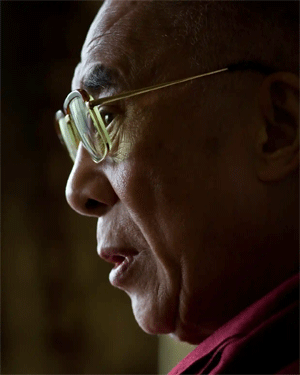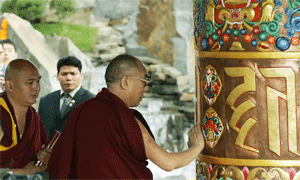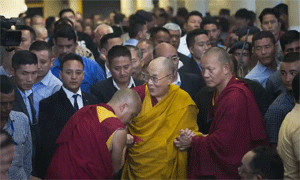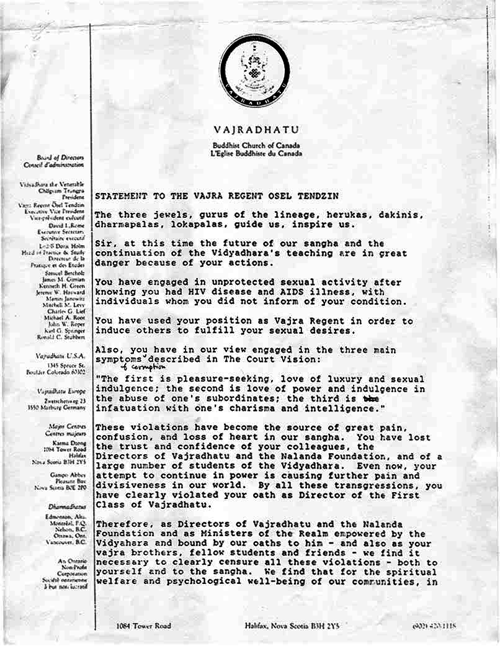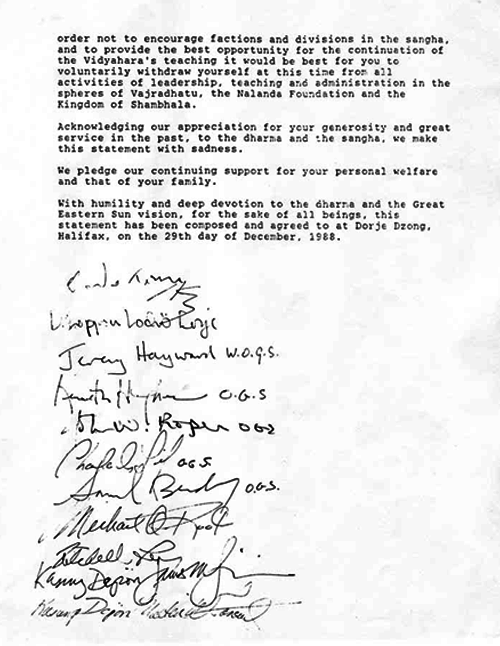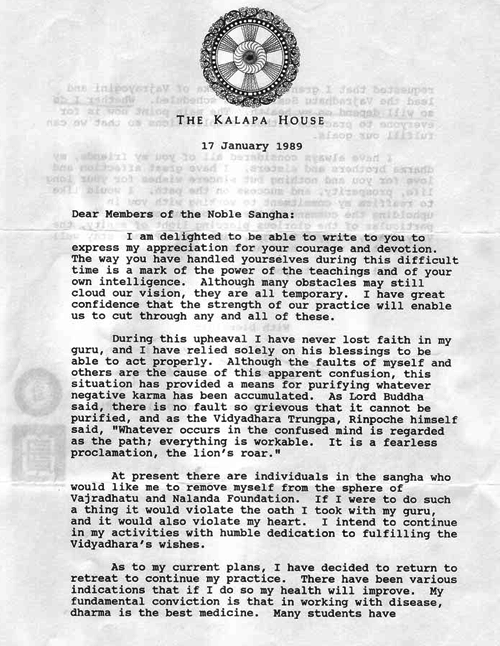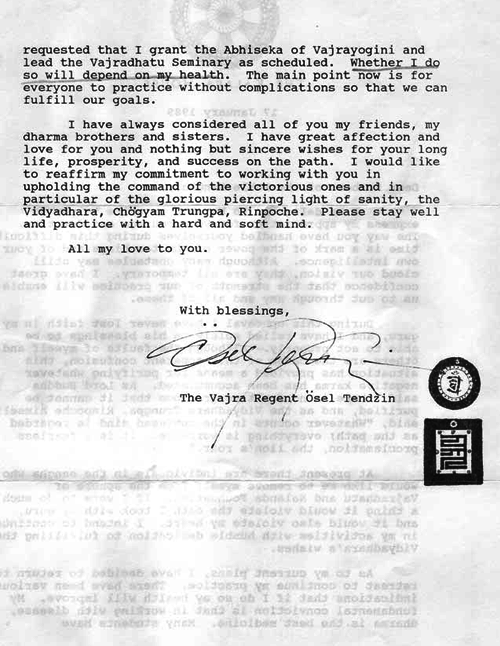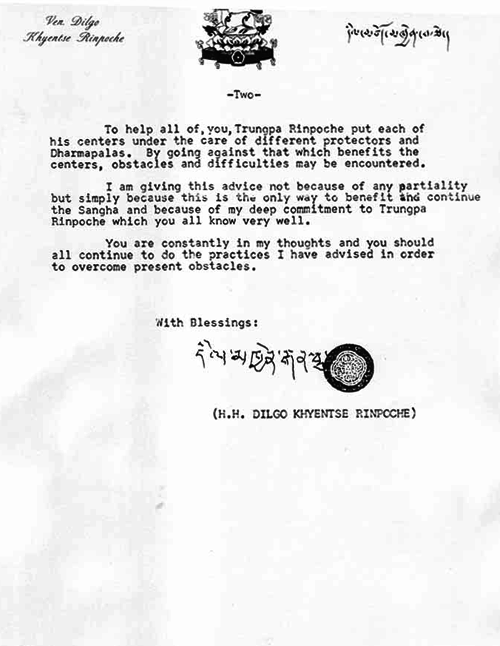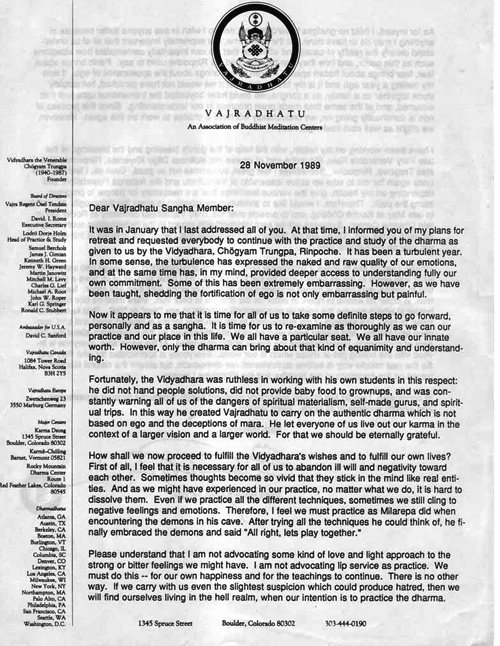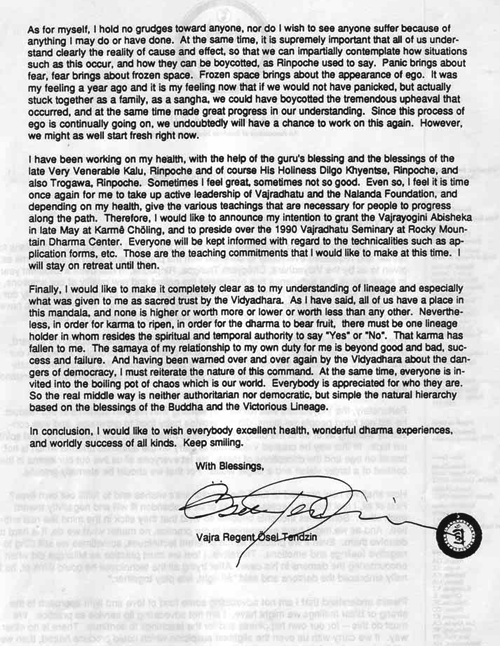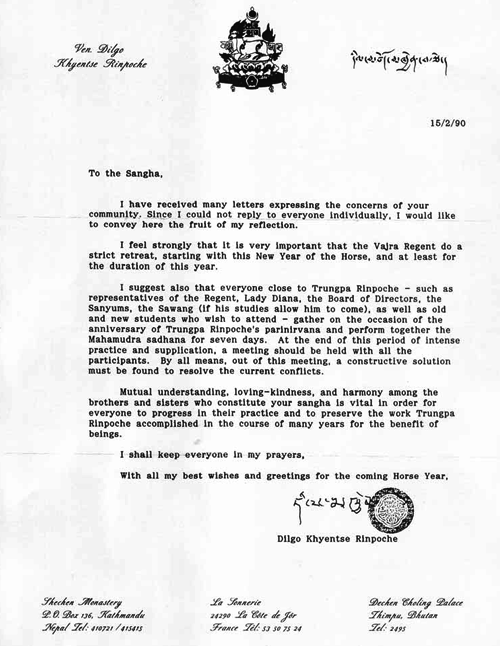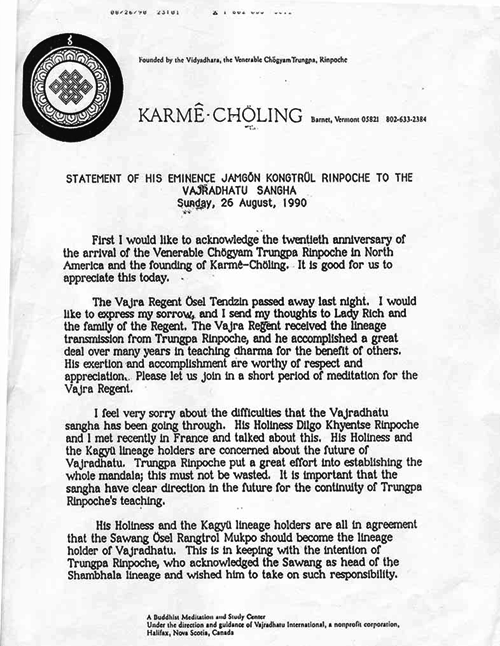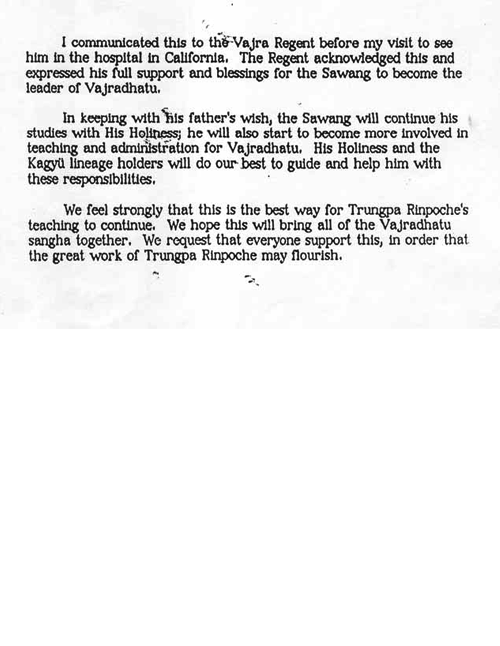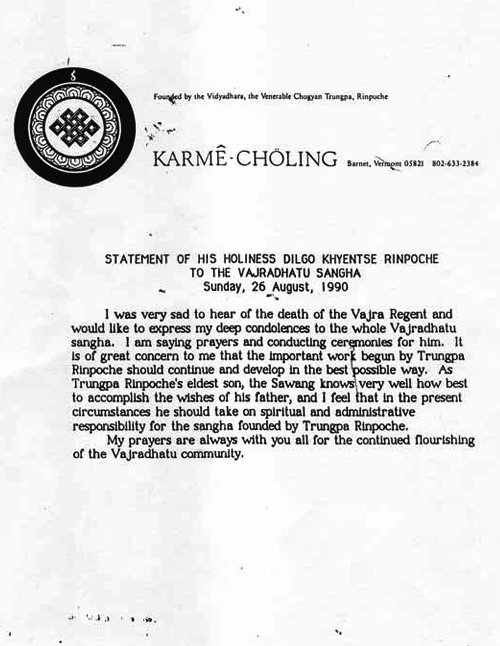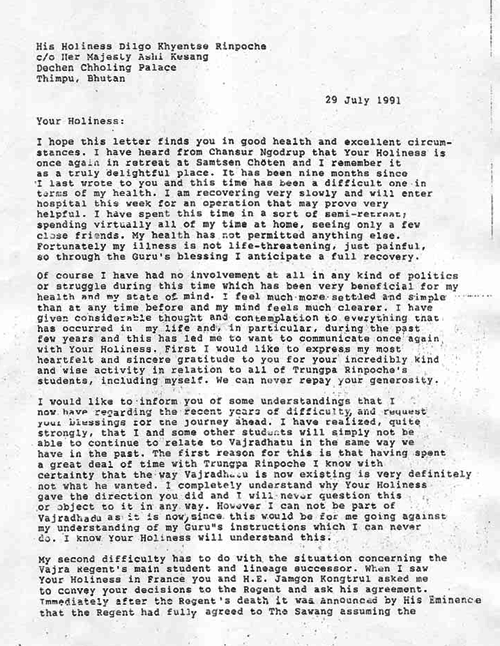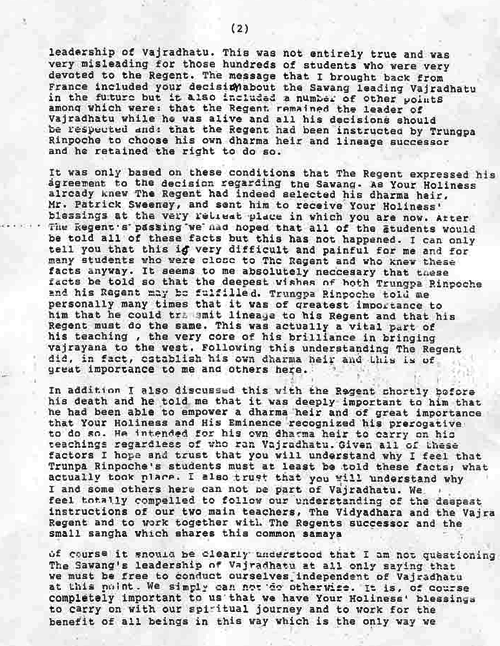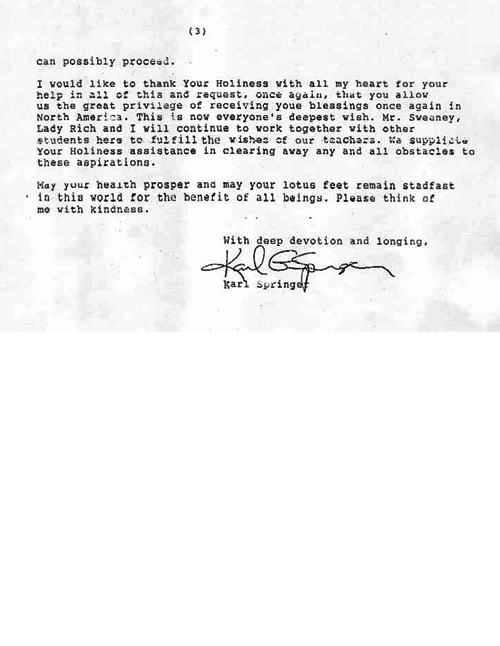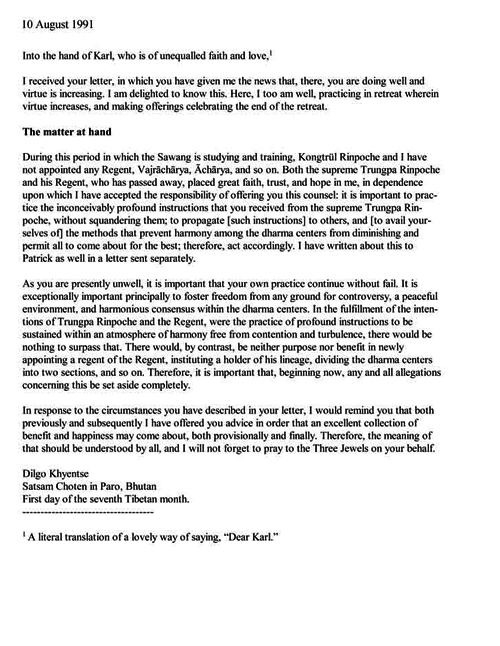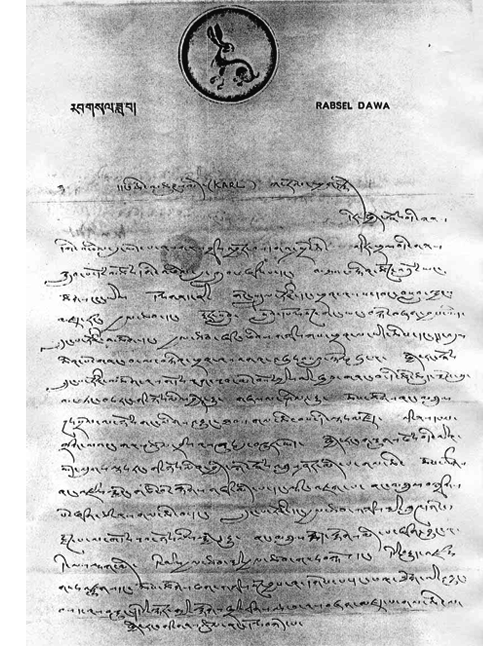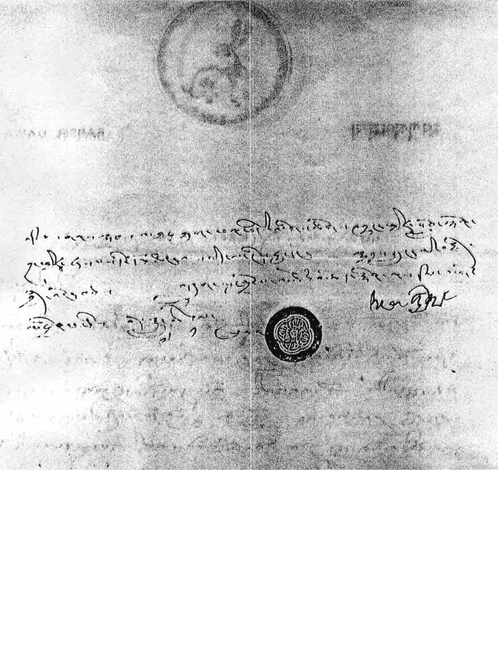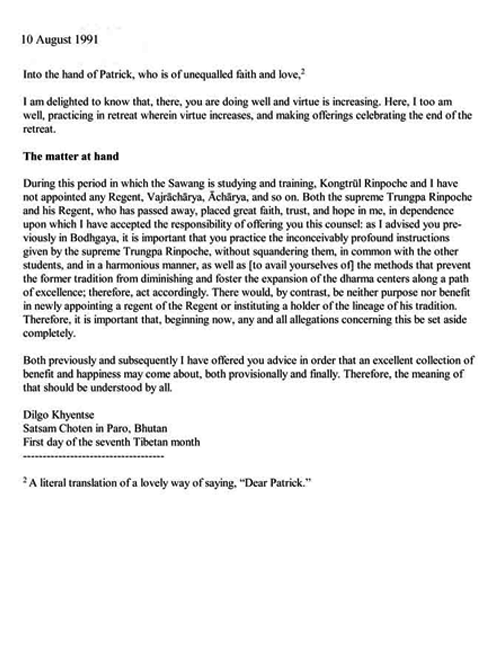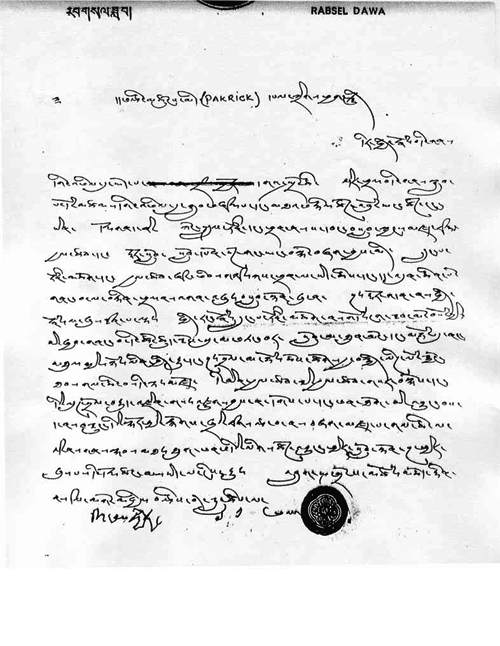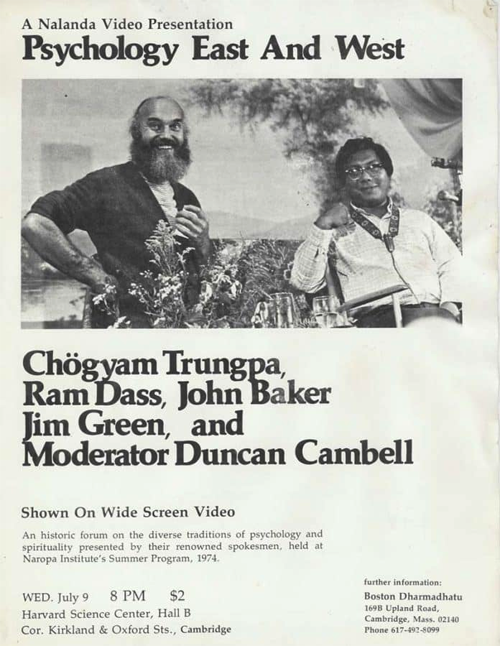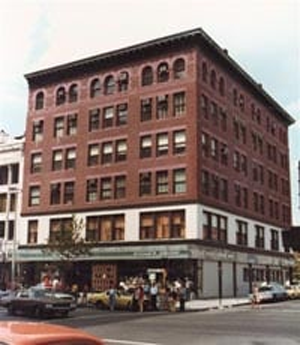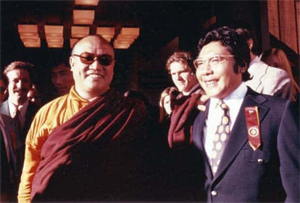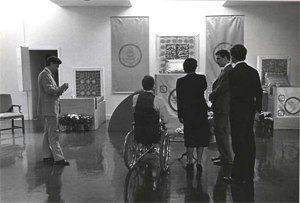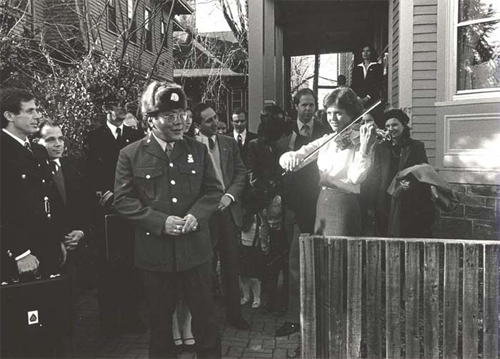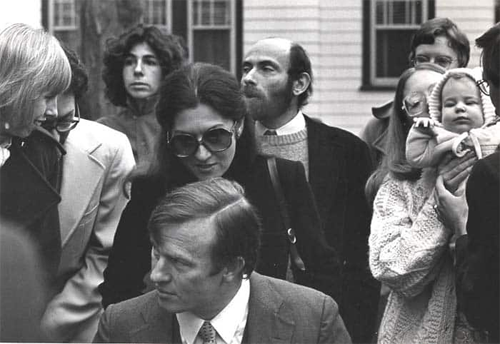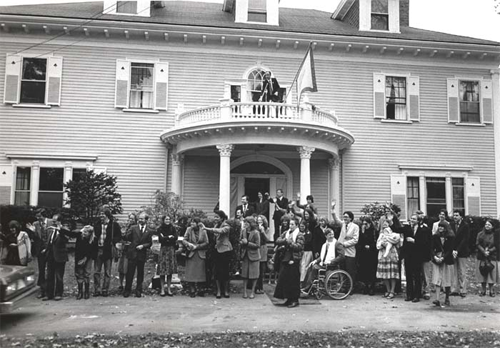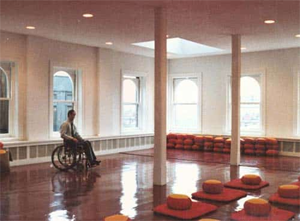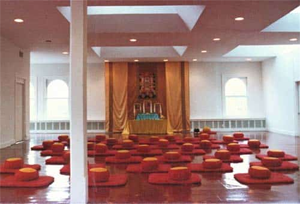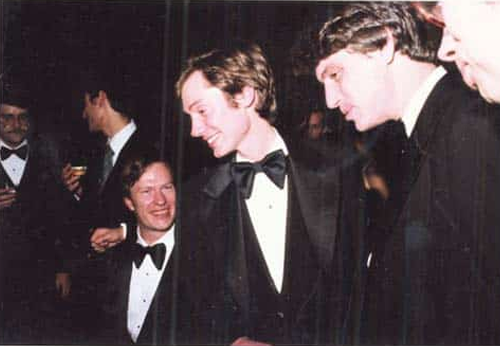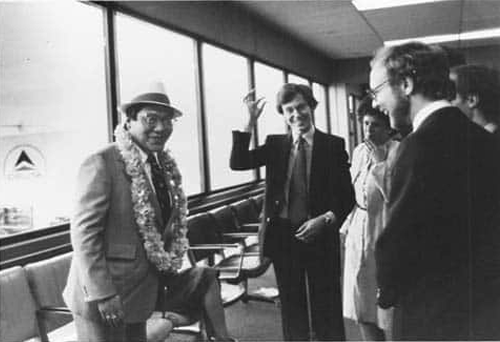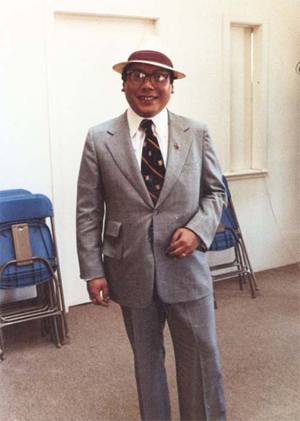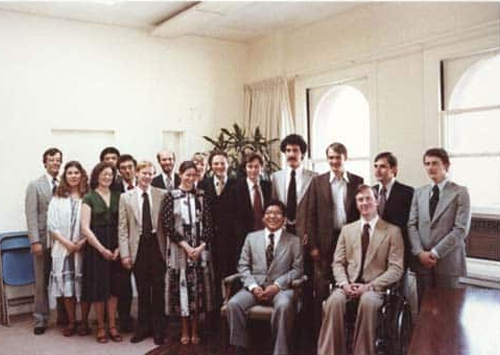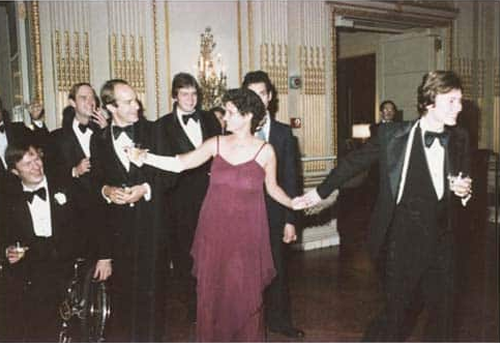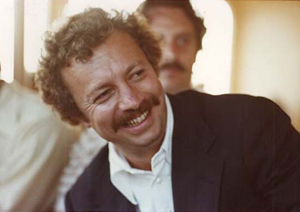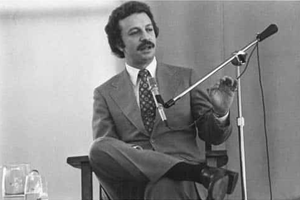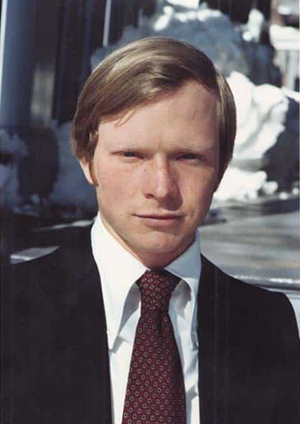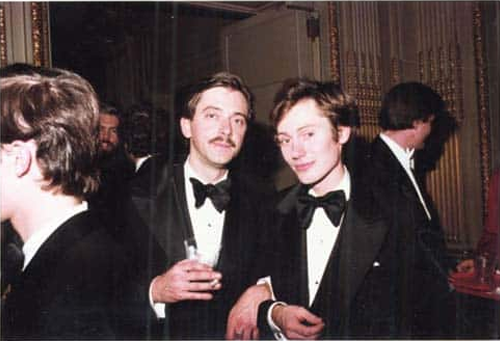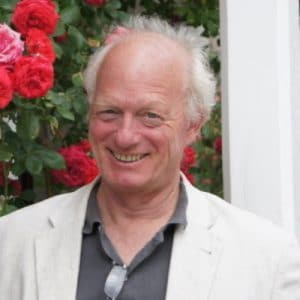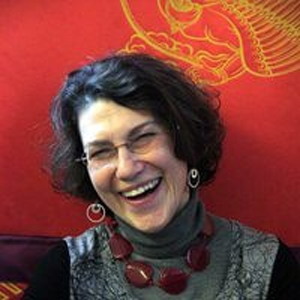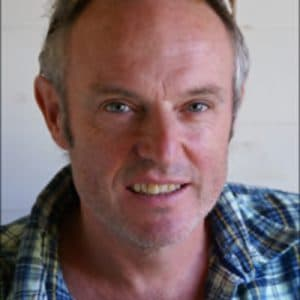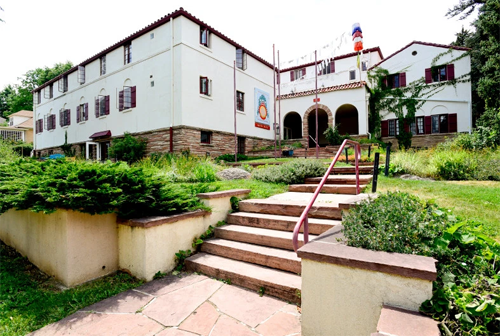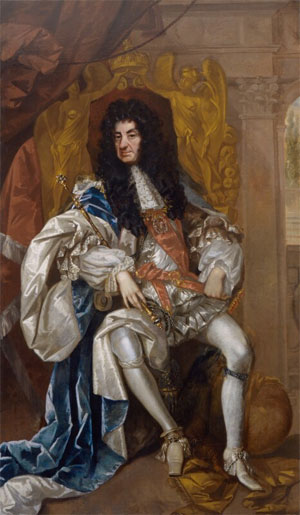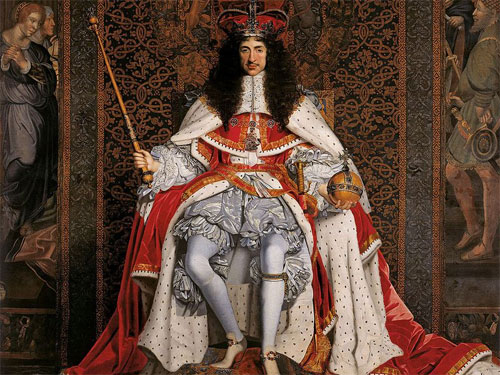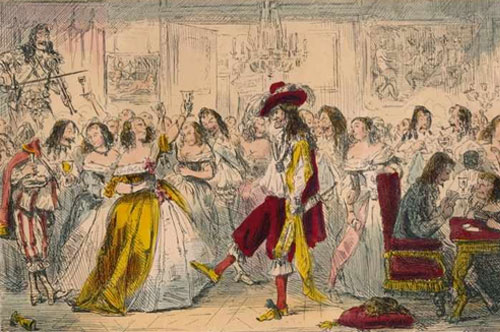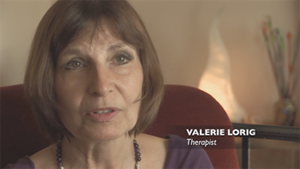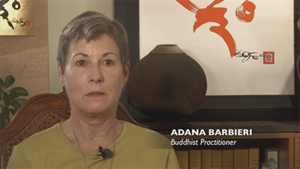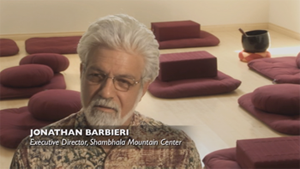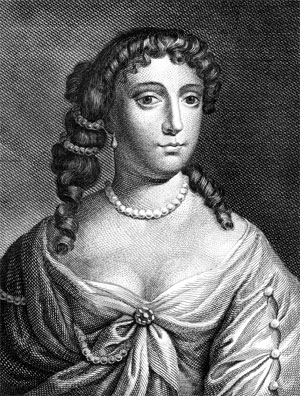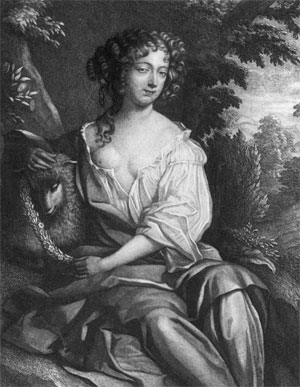East–West Centerby Wikipedia
Accessed: 8/24/19
NOTICE: THIS WORK MAY BE PROTECTED BY COPYRIGHTYOU ARE REQUIRED TO READ
THE COPYRIGHT NOTICE AT THIS LINK BEFORE YOU READ THE FOLLOWING WORK, THAT IS AVAILABLE SOLELY FOR PRIVATE STUDY, SCHOLARSHIP OR RESEARCH PURSUANT TO 17 U.S.C. SECTION 107 AND 108. IN THE EVENT THAT THE LIBRARY DETERMINES THAT UNLAWFUL COPYING OF THIS WORK HAS OCCURRED, THE LIBRARY HAS THE RIGHT TO BLOCK THE I.P. ADDRESS AT WHICH THE UNLAWFUL COPYING APPEARED TO HAVE OCCURRED. THANK YOU FOR RESPECTING THE RIGHTS OF COPYRIGHT OWNERS.
Not to be confused with EastWest Institute.The Boston Dharmadhatu started in 1972 with Patricia Shelton’s hatha yoga group, which met at her East-West Center. We were followers of Rudrananda, Muktananda, Vankatesananda, Vishnudevananda, Satchitananda, Ram Dass and the American Dream. The first official meetings were held at Persis McMillen’s estate in Concord, with Beth Gordon as coordinator. Rinpoche gave a talk there on The Way of the Buddha, which is in the Myth of Freedom. Narayana (later the Regent Osel Tendzin) and Olive Colon gave meditation instruction under a tree and we sat in a little outlying cottage and did walking meditation in the fields. Then we got a small loft on Charles Street, in Beacon Hill. There were 12-15 members and we met on Monday nights.
-- Boston Dharmadhatu: The Early Days, by Anna Taylor
The East–West Center (EWC), or the Center for Cultural and Technical Interchange Between East and West, is an education and research organization established by the U.S. Congress in 1960 to strengthen relations and understanding among the peoples and nations of Asia, the Pacific, and the United States. It is headquartered in Honolulu, Hawaii.History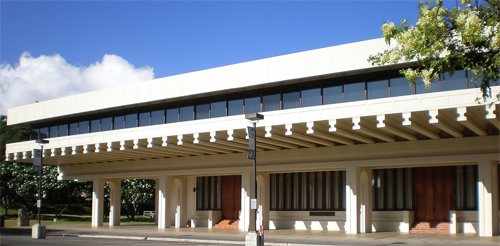 Jefferson Hall Conference Center
Jefferson Hall Conference Center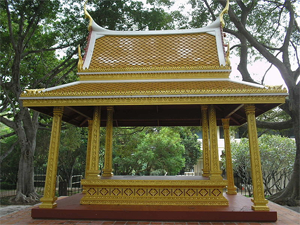 Thai Pavilion
Thai PavilionThe East–West Center originated as a University of Hawaii at Manoa faculty initiative with a February 16, 1959, memo from professor Murray Turnbull, then acting Dean of the College of Arts and Sciences, to political science professor Norman Meller, then chairperson of the faculty senate, that proposed the creation of an International College of Cultural Affairs. However, University of Hawaii President Laurence H. Snyder stated that budgetary constraints prevented proceeding at the time with the idea.[1]
Two months later, following radio reports of an April 16, 1959 speech in Washington, D.C. by then Sen. Lyndon Johnson (D-TX) that proposed the creation of an international university in Hawaii "as a meeting place for the intellectuals of the East and the West," history professor John Stalker and Meller urged President Snyder to respond at once to Johnson's suggestion.[2] With the prospect of federal funding, President Snyder appointed a faculty committee chaired by Turnbull to rapidly prepare a substantive proposal for creating an international college.[3]
On June 9, 1959, Sen. Johnson introduced a bill in the U.S. Senate to establish an educational center in Hawaii to provide for "cultural and technical interchange between East and West," with a companion bill introduced in the U.S. House by Delegate John A. Burns (D-T.H.);[4] the Mutual Security Act of 1959, signed by U.S. President Eisenhower on July 24, 1959, called on the State Department to study the idea and report back to Congress by January 3, 1960.[5]
On May 14, 1960, President Eisenhower signed the Mutual Security Act of 1960 which authorized the creation of a Center for Cultural and Technical Interchange Between East and West (East–West Center) at the University of Hawaii, and on August 31, 1960, signed the Department of State Appropriation Act, 1961, which appropriated $10 million for the Center (including $8.2 million in capital spending for six new buildings), and on September 30, 1961, President Kennedy signed Supplemental Appropriation Act, 1962, which appropriated an additional $3.3 million for the Center.[6]
On October 25, 1960, the University of Hawaii signed a grant-in-aid agreement with the State Department to establish and operate the East–West Center, and received its first installment of $1.1 million in federal funding on November 8, 1960.[7]
University of Hawaii art professor Murray Turnbull served as interim director and acting chancellor of the East–West Center through 1961,[8] when anthropologist Alexander Spoehr, the former director (1953–1961) of the Bernice Pauahi Bishop Museum in Honolulu, was appointed as the East–West Center's first chancellor, serving for two years before resigning at the end of 1963.[9] University of Hawaii president Thomas H. Hamilton served as acting chancellor of the East–West Center for a year and a half from January 1964–June 1965.[10] In July 1965, he was succeeded by former newspaper publisher and diplomat Howard P. Jones, the former U.S. ambassador to Indonesia (1958–1965),[11] who served as chancellor for three years before being succeeded in August 1968 by linguist Everett Kleinjans, the former vice president of International Christian University in Tokyo, who had lived in Asia for sixteen years.[12]
On May 9, 1961, then U.S. Vice President Lyndon Johnson was a guest at groundbreaking ceremonies for the East–West Center's first six buildings.[13] Five of the new buildings, designed by architect I. M. Pei, were built along the new East–West Road where a new 21-acre (85,000 m2) East–West Center campus just west of Manoa Stream on the east side of the university campus replaced chicken coops, temporary wooden buildings for faculty housing, and the Hawaii Agricultural Experiment Station.[14] A sixth building built under the federal grant for the East–West Center was Edmondson Hall, designed by architect Albin Kubala and built on McCarthy Mall.[15]Four of the six buildings were completed and opened in September 1962: Edmondson Hall (a four-story building containing classrooms and laboratories), Kennedy Theatre (an 800-seat theatre), Hale Kuahine (a four-story women's dormitory for 120 students), and Lincoln Hall (a four-story residence hall for senior scholars and faculty).[16] The other two buildings: Jefferson Hall (a four-story conference center, cafeteria, and administrative office building) and Hale Manoa (a 13-story men's dormitory for 480 students) were completed and opened in September 1963.[17] "Seien" (Serene Garden), a Japanese garden designed by Kenzo Ogata of Tokyo, and located behind Jefferson Hall, was a 1963 gift of Japanese business leaders; the Japanese tea house Chashitsu Jakuan (Cottage of Tranquility) in the garden was presented to the university in 1972 by Sen Sōshitsu, the 15th-generation grand tea master of the Urasenke Foundation.[18]
In May 1967, the Thai Pavilion, a gift of King Bhumibol Adulyadej and Queen Sirikit of Thailand in 1964, was assembled just in time for King Adulyadej's dedication of the pavilion on June 6, 1967; it is located between Lincoln Hall and Jefferson Hall, in front of Hale Kuahine.[19]
In 1969, the four-story wing of Moore Hall designed by architect Hideo Murakami was built with East–West Center federal funds on the west side of East–West Road across from Lincoln Hall.[20]
In 1977, John A. Burns Hall, located south of Hale Manoa on the 21-acre (85,000 m2) East–West Center campus, was completed. The four-story building for administrative offices was designed by architect John Hara to integrate with the style of the other East–West Center buildings (its windows mimic those of Lincoln Hall). It was built with State of Hawaii funds to compensate the federal government for the University's use of Edmondson Hall, the Kennedy Theatre, and the 4-story wing of Moore Hall, which had been built with federal funds for the East–West Center.[21]
StructureEWC program areas include Education, Research, Seminars, a Washington, D.C. office (which also houses and administers the United States Asia Pacific Council), an Office of External Affairs and the East–West Center Foundation.East-West Center Foundationby East-West Center
Accessed: 8/24/19
The East-West Center Foundation is a private non-profit organization, established in 1982 to broaden and diversify private support for the Center. The success of the East-West Center is built on effective public-private partnerships. Funding from the US government covers most of the Center's basic operating expenses, while programming depends on private funding by individuals, private agencies, foundations, corporations and governments throughout the region. Increasing private support makes it possible to continue and expand its most high-impact programs and create new initiatives.
The East-West Center Foundation is guided by a board of directors drawn from business and community leaders, and includes a representative of the East-West Center Alumni Association.
EWC Foundation StaffJody Huckaby
Advancement Director
1601 East-West Road
Honolulu, Hawaii 96484-1601
Phone: (808) 944-7437
Fax: (808) 944-7106
Email:
HuckabyJ@EastWestCenter.orgGary Yoshida
Development Officer
1601 East-West Road
Honolulu, Hawaii 96848-1601
Phone: (808) 944-7196
Fax: (808) 944-7106
Email:
YoshidaG@EastWestCenter.orgJennifer Leger
Development Associate
1601 East-West Road
Honolulu, Hawaii 96848-1601
Phone: (808) 944-7105
Fax: (808) 944-7106
Email:
LegerJ@EastWestCenter.orgFoundation Board of DirectorsChair
Mr. Russell J. Lau
Chairman and CEO
Finance Factors, Ltd.
Honolulu, HI
Vice Chair
Ms. Gae Bergquist Trommald
Senior Financial Advisor, AVP, CRPC, Partner
The Hochuli Group of Merrill Lynch
Honolulu, Hawaii
Elected
Mr. Aaron J. Alter
Executive Vice President &
Chief Legal Officer
Hawaiian Airlines
Honolulu, HI
Mr. Kelvin M. Bloom
Honolulu, HI
Mr. Eddie Flores, Jr.
President and CEO
L&L Drive-Inn and L&L Hawaiian Barbecue
Honolulu, HI
Dr. Richard S. Kennedy
Honolulu, HI
Ms. Corianne W. Lau, Esq.
Partner
Dentons US LLP
Honolulu, HI
Ms. Sharon Lucien
Principal
Lucien Consulting
Honolulu, HI
Mr. Raoul Magana, CFA
Vice President, Commercial Real Estate Division
First Hawaiian Bank
Honolulu, HI
Jean E. Rolles
Honolulu, HI
Ms. Trudy Schandler-Wong
Honolulu, HI
Mr. Gulab Watumull
President
Watumull Brothers, Ltd.
Honolulu, HI
Ms. Denise Hayashi Yamaguchi
Executive Director, Hawaii Agriculture Foundation
CEO, Hawaii Food & Wine Festival
Honolulu, HI
Member Appointed by East-West Center Board of Governors
Mr. R. (Rick) Brian Tsujimura
Of Counsel, Ashford & Wriston, LLP
Honolulu, HI
EWCA Representative (Invited by the Board)
Ms. Susan Heftel-Liquido
Vice President for Development
Chair, Develoment Committee, EWCA
Retired President/CEO
Heftel Management
Honolulu, HI
East-West Center Foundation Officers
President
Dr. Richard R. Vuylsteke
Vice President
Ms. Karen Knudsen
Treasurer
Mr. Ralph Carvalho
Assistant Treasurer
Mr. Clinton Nonaka
Corporate Secretary
Ms. Carleen G. Gumapac
Members of the Foundation Board are active in the Center's vibrant, international community and engaged partners in bringing the cultural vitality and diversity of the Center into the Honolulu and regional communities.
In Honolulu, opportunities include attendance to:
• art performances and gallery shows; addresses by regional leaders and talks by visiting media, analysts, and other experts
• trainings for young and emerging leaders focusing on the environment and economic social entrepreneurship
• student/participant programming including the Concert on the Lawn
In addition, Foundation members can assist students professionally by serving in the Mentoring Program and by assisting the Education Program with student recruitment and networking on behalf of students (student services link). Foundation members can also serve as Host Families for students through the Friends of the EWC.
In the region, the Center holds an international alumni conference and an international media conference every two years, and in-field programming is increasingly drawing on Center supporters and alumni for input and insight.
Research ProgramThe Research Program conducts studies on economic development, trade, energy, governance, politics, security, conflict reduction, population, health, and environment. Under the Research umbrella is the Pacific Islands Development Program (the research and training arm and regional secretariat of the Pacific Islands Conference of Leaders representing 22 Pacific island nations).Education ProgramThe Education Program offers educational opportunities for students and professional development seminars and workshops for educators from the U.S. and the region. The Student Program is carried out in partnership with the University of Hawaii and other universities in Hawaii and the continental U.S. scholarships are awarded annually in an international competition.
Also under the Education Program are the Asia Pacific Leadership Program (APLP) (a certificate program for graduate-level students and mid-level professionals)[1], AsiaPacificEd and the Asian Studies Development Program (both work with primary, secondary, and college educators to infuse Asian Pacific content in curricula), and Education 2020 (a focus on new approaches to educational challenges in the Asia Pacific Region). Most of education program participants reside in EWC dormitories like Hale Manoa Dormitory.
East–West SeminarsEast–West Seminars bring professionals from government, civil society, business and the media together for short-term dialogue and exchange programs to share knowledge and address issues of regional and global concern. Included in the Seminars Program are the Media Program (provides journalist with first-hand examination of issues in the region and the U.S.), Senior Policy Seminar (brings together top level foreign affairs and security officials, private sector and civil society leaders to discuss key regional issues), and the Asia Pacific Executive Forum (brings to American cities discussions on topics that affect the economics and business of the region). The East–West Center also organizes various women empowerment programs. It recently organized 2014 Changing Faces Women’s Leadership Seminar at Hawaii which saw the participation of 13 women entrepreneurs from the Asia Pacific Region.
Office of External AffairsThe Office of External Affairs (OEA) connects the resources and research of the EWC with the local, national, and international community through educational outreach, public programs, briefings, and media relations. Within the OEA is the News and Information office (provides EWC research findings, opinion pieces, and analysis of issues to journalists and the public), the Arts Program (presents performances and exhibitions illuminating the cultural values and art forms of national and ethnic traditions in the region), and the Alumni Office (works with an international network of professionals from more than 50 countries who have had a past affiliation with the EWC).
East–West Center FoundationThe East–West Center Foundation expands and enhances support for the EWC with private resources that support scholarships, research, and seminar initiatives not covered by core Congressional funding.
FundingApproximately half of Center funding comes from the U.S. government, with additional support provided by private agencies, individuals, foundations, corporations, and the governments of the region. In 2005 the EWC received a total of $37 million (including $19.2 million from the U.S. Congress).On May 7, 2009, President Barack Obama requested a reduction in federal funding for the EWC, from $21 million in fiscal year 2009 to $12 million for fiscal year 2010.[22] The outcome of the 2010 request was a $2 million increase in the Center's budget.[22] Subsequently in 2011, a request to reduce the budget by 50% (reduction by $10.7 million) was placed as part of the budget proposal.[22] The outcome of this request was a $2 million decrease in the Center's budget.[22]
ImpactThe impact of the EWC is far-reaching. More than 50,000 people have participated in EWC programs since 1960, including many who currently hold positions of leadership throughout the United States and the Asia Pacific.
Alumni include heads of government, cabinet members, university and NGO presidents, corporate and media leaders, educators and individuals prominent in the arts.East–West Center GalleryThe East–West Center Gallery presents changing exhibits of traditional and contemporary arts of the Pacific region. The gallery is located on the campus of the University of Hawaii, and is open daily except Saturday. Cultural performances are also presented.
Hale Manoa Dormitory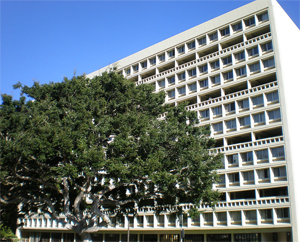 Hale Manoa Dormitory
Hale Manoa DormitoryHale Manoa is the East–West Center's student dormitory.[23] This 13-story building, constructed in 1962, was designed by American architect I. M. Pei, and is located in the University of Hawaii, Honolulu.[24] The dormitory has a housing capacity of more than 400. This is a predominantly graduate student dormitory and most of the residents are mainly recipients of East West Center scholarships or are affiliated with their programs. Hence here there are EWC Graduate Degree Fellows, Asia Pacific Leadership Program participants, EWC Affiliates and others who are not directly funded by the EWC. A large majority of the residents are international students from the Asia-Pacific region like China, Japan, Thailand, Vietnam, and Indonesia. Recently, there has been a move to bring in more students from South Asian countries.
It was an all-male dormitory, whereas a sister dormitory, Hale Kuahine, situated just next to the Imin Center and also a I. M. Pei building, housed all the females. Currently, both Hale Manoa and Hale Kuahine are unisex dormitories.
Notes1. Kamins (1998), pp. 77–81.
Turnbull, Murray (1959–1991). Papers related to the founding of the East–West Center. Honolulu. OCLC 60710891.
Turnbull, Murray (November 11, 2003). "Faculty initiative". The Honolulu Advertiser. p. 9A.
2. Kamins (1998), pp. 77–81.
Lawrence, W. H. (April 17, 1959). "Butler cautions South on rights; Warns 1960 platform will back integration – Editors also hear Fulbright". The New York Times. p. 17. Retrieved 2008-12-05.
3. Kamins (1998), pp. 77–81.
4. Kamins (1998), pp. 77–81.
Boylan (2000), pp. 168–169.
. (June 10, 1959). "Hawaii center sought; Bills call for an East–West educational bridge". The New York Times. p. 39. Retrieved 2008-12-05.
5. U.S. Congress (1962), pp. 5, 194–196.
. (November 14, 1959). "East–West Center due for approval". The New York Times. p. 5. Retrieved 2008-12-05.
6. U.S. Congress (1962), pp. 5, 194–196.
Eisenhower, Dwight D. (May 16, 1960). "Statement by the President Upon Signing the Mutual Security Act of 1960". The American Presidency Project. Retrieved 2008-12-05.
7. U.S. Congress (1962), pp. 5, 194–196, 200.
Sutton, Horace (November 12, 1960). "Where the twain will meet". Saturday Review. pp. 44, 47–48.
. (December 18, 1960). "News notes: Classroom and campus". The New York Times. p. E7. Retrieved 2008-12-07.
8. Kamins (1998), pp. 77–81.
U.S. Comptroller General (1978), p. 42 (Appendix II. Principal officials concerned with matters discussed in this report).
Tswei, Suzanne (April 19, 1999). "Honored artist and educator Murray Turnbull's always took an unorthodox approach to teaching, and he's still improvising on his life and career". Honolulu Star-Bulletin. Retrieved 2008-12-07.
Oshirio, Joleen (January 27, 2008). "Articulating an artistic reality; Murray Turnbull has spent his career giving form to ideas". Honolulu Star-Bulletin. Retrieved 2008-12-07.
9. Kamins (1998), pp. 77–81.
U.S. Comptroller General (1978), p. 42 (Appendix II. Principal officials concerned with matters discussed in this report).
Oliver, Douglas (1996). "Alexander Spoehr". In National Academy of Sciences (U.S.) (ed.). Biographical memoirs. Volume 69. Washington D.C.: National Academy Press. ISBN 0-309-05346-3. Retrieved 2008-12-07.
. (July 21, 1961). "Awakening in Hawaii". Time. pp. 46, 49. Retrieved 2008-12-07.
. (April 2, 1962). "Trouble in the East–West Center". Newsweek. p. 84.
Bartlett, Stephen W. (July 18, 1964). "Hawaii's East–West Center: A dialogue between cultures". Saturday Review. pp. 44–47, 61–62.
10. Kamins (1998), pp. 77–81.
U.S. Comptroller General (1978), p. 42 (Appendix II. Principal officials concerned with matters discussed in this report).
. (November 28, 1964). "Where the twain get together". Business Week. pp. 34–35.
. (February 26, 1965). "New tides in the Pacific". Time. pp. 66–67. Retrieved 2008-12-07.
Davies, Lawrence E. (May 23, 1965). "Hawaii students aware of issues; Speakers of all viewpoints invited to Pacific campus". The New York Times. p. 49. Retrieved 2008-12-07.
11. Kamins (1998), pp. 77–81.
U.S. Comptroller General (1978), p. 42 (Appendix II. Principal officials concerned with matters discussed in this report).
Shavit, David (1990). The United States in Asia: A historical dictionary. New York: Greenwood Press. p. 270. ISBN 0-313-26788-X.
Trager, Frank N. (August 29, 1965). "The U.S. and Indonesia – A tragedy in diplomacy". The New York Times Magazine. p. SM26. Retrieved 2008-12-07.
Davies, Lawrence E. (July 4, 1966). "Center defines East–West needs; It hopes to respond more to Asian requirements". The New York Times. p. 3. Retrieved 2008-12-07.
. (September 20, 1973). "Howard P. Jones Is dead at 74; Envoy to Indonesia, 1958–65". The New York Times. p. 50. Retrieved 2008-12-07.
12. Kamins (1998), pp. 77–81.
U.S. Comptroller General (1978), p. 42 (Appendix II. Principal officials concerned with matters discussed in this report).
Davies, Lawrence E. (October 26, 1969). "Scholars revise Hawaiian center; Problem-solving is stressed by cooperating cultures". The New York Times. p. 32. Retrieved 2008-12-07.
Trumbull, Robert (January 13, 1972). "Alumni of East–West Center in Hawaii are holding influential posts in Asia". The New York Times. p. 14. Retrieved 2008-12-07.
Turner, Wallace (April 1, 1975). "Asian-Pacific cultural and technical interchange institution is facing major changes". The New York Times. p. 15. Retrieved 2008-12-07.
Trumbull, Robert (November 6, 1980). "Scholars of world lured to Hawaii; East–West Center, set up by U.S. to improve international ties, has a creative approach". The New York Times. p. A15. Retrieved 2008-12-07.
13. Kamins (1998), pp. 78–79.
Kobayashi (1983), p. 127.
Associated Press (May 10, 1961). "Johnson lands in Hawaii". The New York Times. p. 19. Retrieved 2008-12-05.
14. Kobayashi (1983), pp. 111–112, 114, 122–132.
15. Kobayashi (1983), pp. 122–126.
16. Kobayashi (1983), pp. 111–112, 114, 122–132.
. (May 13, 1962). "East–West link rising in Hawaii; Center's first buildings due for use in September". The New York Times. p. 11. Retrieved 2008-12-07.
17. Kobayashi (1983), pp. 111–112, 114, 122–132.
Davies, Lawrence E. (June 2, 1963). "Hawaii nurtures U.S.-Asian amity; Study center brings people of 26 nations together". The New York Times. p. 31. Retrieved 2008-12-07.
18. Kobayashi (1983), pp. 126, 128-129.
19. Kobayashi (1983), pp. 140–141, 143.
20. Kobayashi (1983), pp. 114, 146, 148.
21. Kobayashi (1983), pp. 114, 126, 130.
22. David A. Fahrenthold (20 April 2011). "Even in an era of budget cuts, these government programs won't die". The Washington Post. PostPolitics. Retrieved 21 April 2011.
23. "Place Names of Hawaii - Hale Manoa". Retrieved 29 December 2015.
24. "Hale Manoa Dormitory". Emporis is a global provider of building information. Retrieved 29 December 2015.
References• Boylan, Dan; Holmes, T. Michael (2000). John A. Burns: The man and his times. Honolulu: University of Hawaii Press. ISBN 0-8248-2277-3.
• Kamins, Robert M.; Potter, Robert E. (1998). Malamalama: A history of the University of Hawaii. Honolulu: University of Hawaii Press. ISBN 0-8248-2006-1.
• Kobayashi, Victor N. (1983). Building a rainbow: A history of the buildings and grounds of the University of Hawaii's Manoa Campus. Honolulu: University of Hawaii at Manoa. hdl:10524/654. OCLC 10579299.
• U.S. Comptroller General (Staats, Elmer B.) (1978). East–West Center: progress and problems. Report to Congress (PDF). Washington D.C.: General Accounting Office. OCLC 3867189. Retrieved 2008-12-07.
• U.S. Congress House Committee on Foreign Affairs (1962). Center for Cultural and Technical Interchange between East and West (East–West Center). Hearings before the Subcommittee on State Department Organizations and Foreign Operations of the Committee on Foreign Affairs, House of Representatives, Eighty-seventh Congress. December 13, 14, 1961, January 8, 1962. Washington: U.S. Government Printing Office. OCLC 16326474.
External links• East–West Center
• East–West Center Washington, DC
• East–West Center Gallery
• East–West Center Alumni Blog
• University of Hawai'i at Manoa
****************************
Ann Hartmanby East-West Center
Accessed: 8/24/19
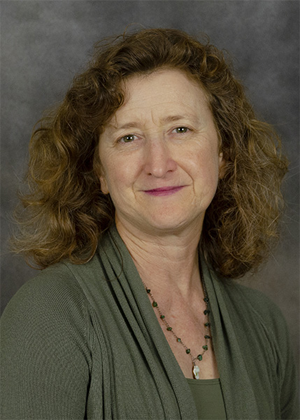
Dean, Education Program
hartmana@EastWestCenter.orgPhone:
808.944.7619
Fax:
808.944.7070
Education: M.A., International Education, University of Massachusetts, Amherst; B.A., Psychology, St. Olaf College, Minnesota, Teaching Certifications Grade 7-12, English as a Second Language and Social Studies
Area of Expertise: International education and training, building Asia Pacific regional knowledge and networks among students, young leaders and journalists, women’s entrepreneurship and leadership development, Pakistan-US relations and media environment in Pakistan
Ms. Ann Hartman is Dean of the East-West Center Education Program. She provides overall leadership for the Center’s graduate student programs, ensuring an enriching intellectual, social and cultural experience for students in residence at the EWC, a cooperative relationship with the University of Hawaii, and international partnerships with institutions across the Asia Pacific region.
Previously, she spent 15 years in the Seminars Program at the East-West Center, coordinating short-term professional development and exchange experiences for journalists, young leaders and women entrepreneurs. She led the East-West Center’s two flagship short-term dialogue and exchange programs: the Jefferson Fellowships for journalists and the New Generation Seminar for young leaders. Through this work, she built partnerships in and led visits to Cambodia, China, Indonesia, Korea, Japan, Vietnam, Philippines, Pakistan, Myanmar and India in Asia and Youngstown, Milwaukee, Austin, Seattle, Lowell, Boston, Miami and Washington, DC among other cities in the United States on topics such as climate change, innovation offshoring, health issues, the politics of globalization, the global economic crisis, Asia Pacific security and the U.S. role, the future of jobs, the South China Sea, and heritage preservation. From 2011-2014, she designed and led a Pakistan-U.S. Journalists Exchange, bridging gaps in understanding between the two countries through study tours and dialogue. From 2008-2017, she was the co-coordinator for the Changing Faces Women’s Leadership Seminar, a training program for female innovator entrepreneurs. Ms. Hartman co-authored the book chapter, “Changing Faces Women’s Leadership Seminar: A Model for Increasing Asia Pacific Women’s Entrepreneurial Participation,” in the 2014 academic text Women and Leadership Around the World.
Ms. Hartman came to the East-West Center in 2002 from a career in teaching, training, and program administration. She was Associate Peace Corps Director for programming and training in Uzbekistan (1997–2001), where she assured quality work assignments and training for 150 volunteers and positive development outcomes for the Government of Uzbekistan. She was a Peace Corps volunteer teacher and teacher trainer in Multan, Pakistan (1990-1991) and Stara Zagora, Bulgaria (1991-1993).
Ms. Hartman received her master’s degree in international education from the Center for International Education at the University of Massachusetts, Amherst and her BA from St. Olaf College in Minnesota. She has teaching certifications in social studies and English as a second language.
****************************
Namji Steinemannby
East-West CenterAccessed: 8/26/19
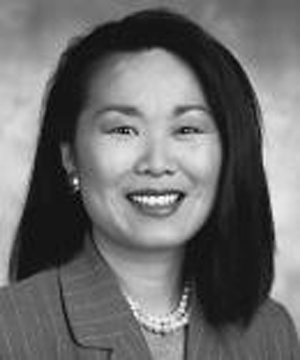
Director, AsiaPacificEd Program for Schools
SteinemN@EastWestCenter.orgPhone: 808.944.7596
Fax: 808.944.7070
Area of Expertise: K-12 education on Asia and the Pacific region; Policy and curriculum issues for improved Asia Pacific-related education; Asian American history and related issues
Namji Steinemann is associate director of the EWC Education Program and directs the AsiaPacificEd Program, a national program that helps K-12 schools meet curriculum, assessment and instructional needs concerning the Asia Pacific region.
She is the former vice president of the Asia Society’s Education Program and the chief architect of the Society’s Asia in the Schools program. She also served as executive director of the National Commission on Asia in the Schools. Formerly, Steinemann was a Peace Corps teacher in Thailand. She currently serves on the editorial board of Education About Asia, and is active in the National Council for Social Studies Teacher Education and Professional Development committees, and the Notable Social Studies Trade Books for Young People Selection Subcommittee. She is a graduate of East Carolina University and has lived in Korea, Thailand and France.
***
East-West Center Pressby University of Hawaii Press
Accessed: 8/24/19
Ways of Thinking of Eastern Peoples: India, China, Tibet, Japan (Revised English Translation): East-West Center Press
Deutsch, Eliot. 1969. Advaita Vedanta: A Philosophical Reconstruction. Honolulu: East-West Center Press.
Schopenhauer and Buddhism, by Peter AbelsenAmsterdam, Holland
Philosophy East & West, Volume 43, Number 2
April 1993
by University of Hawaii Press
***********************
Educationby eastwestcenter.org
Accessed: 10/18/22
Education Program: A multicultural student community committed to positive changeThe East-West Center's graduate student programs, carried out in cooperation with the University of Hawai‘i (UH), are designed to foster a shared sense of community and develop the leadership skills and regional literacy needed for regional cooperation and community building among nations. Since it was established in 1960 by the U.S. Congress, the East-West Center has supported more than 8,000 students from Asia, the Pacific, the United States, and around the world. Graduate students from over 40 countries, Hawai‘i, and from across the U.S. live in residence at the Center, where they learn, work, and live together. Through cultural exchange, shared experiences, and collaborative preparation for future leadership roles throughout the region, the East-West Center experience creates lasting relationships and an active network of people committed to positive change.
Subscribe to our electronic newsletter to receive periodic email announcements and updates about our student scholarships and fellowships.
